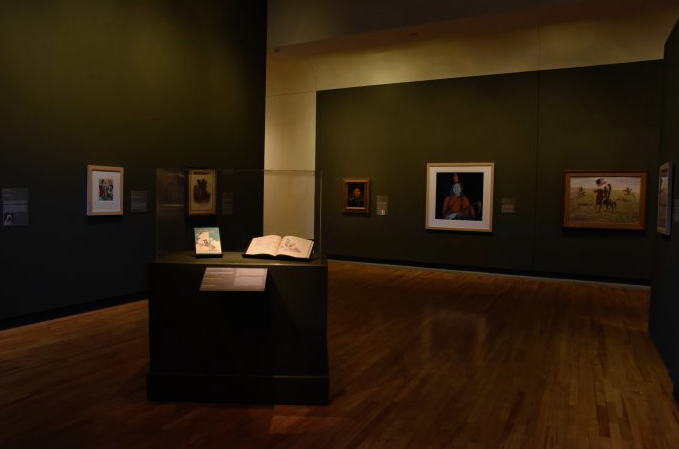‘Voices of the West’ exhibition offers new perspective on Wild West tales

Perceptions of the American West have been heavily shaped by novels, movies and television portrayals that often fail to recognize the stories of America’s original inhabitants.
An exhibition titled “Voices of the West” on display in the Beach Museum of Art gives voice to indigenous peoples and their art.
Curator Liz Seaton said “Voices of the West” is designed to complement an exhibition on Kansas Regionalist John Steuart Curry and his depiction of the American West.
“The Curry exhibition presents primarily a white, European point of view — the view of those who were essentially immigrants to the West,” Seaton said via email. “‘Voices of the West’ offers alternative perspectives on the historic and modern American West. Several images by American Indian artists, for example, address the displacement of Native Americans and the challenge of maintaining cultural traditions.”
One artist whose work is on display in the exhibition is Norman Akers, an associate professor of visual art at the University of Kansas and a member of the Osage Nation from Grayhorse District and the Pawnee Nation.
In Akers’s small monoprint “New Company,” U.S. historical icons Alexander Hamilton, Ulysses S. Grant and George Washington hover over maps of the Americas in spacecrafts, arriving as immigrants to the New World. European stereotypes of Native Americans are emphasized in the central print and shifted boundaries on the maps depict the displacement of indigenous peoples.
“I want to engage people in conversations about these issues,” Akers said. “With my work I am trying to explore imagery that will engage people in the act of looking, and through that process of looking that they begin to start to see some of these issues.”
Issues addressed by Akers’s work are often overlooked in history presented through tales of the American West, Seaton said. She said she hopes the exhibition will provide a positive educational experience for visitors.
“I tend to think that it’s important to be able to see other perspectives,” Akers said. “To get an understanding of the place where one lives, you need to be aware of the history of that place. The fact is that history does not come from one point of view … I think that’s why exhibits like this that reexamine perspectives on place are very important.”
Seaton said two paintings in the exhibition by Potawatomi artist Louis ShipShee have just returned from a conservation center in Omaha, Nebraska where the surfaces were cleaned to reveal details, brightening colors and a clearer picture of historical subjects. Visitors also have an opportunity to contribute to the conservation of art on display in the exhibition.
“The public will also have an opportunity to view a 19th-century painting — a majestic mountain scene by Edward Moran — that needs conservation,” Seaton said. “They’ll be able to read the conservator’s recommendations and make a donation in a nearby box, knowing that they’ve had a part in bringing the painting back to life.”
Conservation of “Western Landscape” is estimated to cost $2500. If enough funds are raised, the painting will be sent to Omaha for treatment and will continue to tell a part of this exhibition’s story.
“Indigenous people have a certain awareness of the West, and on the other end, settlers have a different awareness of the West,” Akers said. “But when you’re trying to get an understanding of that big picture, you have to take in all those different accounts.”
